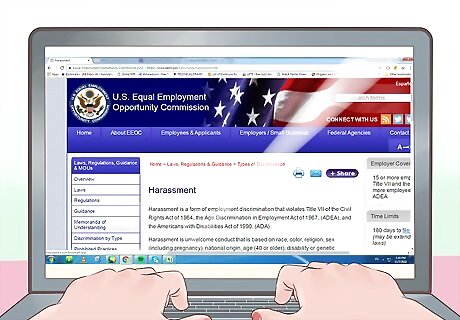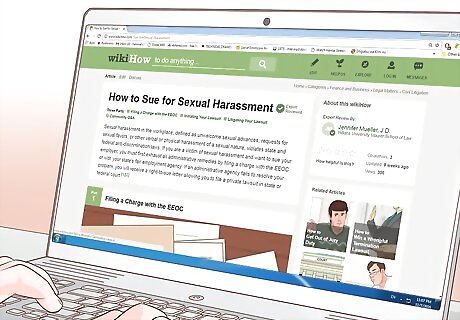
views
X
Research source
When your tormentor has been motivated by your sex, then you may have suffered sexual harassment. However, sexual harassment law has been developed the most in the area of workplace harassment. Sometimes sexual harassment is obvious, for example, an offer of a favor at work in exchange for sex. But identifying harassment can be more complicated when you are dealing with sexual jokes, offensive comments, or flirtation. To see if you have experienced sexual harassment in the workplace, document all offensive conduct and then analyze it based on the factors a court would look at. If you need help, reach out to an employment lawyer who can analyze the facts of the case for you.
Understanding What Qualifies as Sexual Harassment

Identify harassing behavior. In general, anything you find offensive can be harassing—especially when your tormentor knows that the behavior upsets you. However, not all offensive behavior will qualify as harassment. Instead, harassment is usually targeted behavior meant to annoy, terrorize or torment you, and can take the following forms: stalking cyberstalking a pattern of menacing behavior communicating threats to your safety

Research workplace sexual harassment. Sexual harassment law has been developed the most in employment. Congress has made it illegal to discriminate based on sex, and this discrimination includes sexual harassment. You should research workplace sexual harassment. The federal Equal Employment Opportunity Commission investigates allegations of workplace sexual harassment and publishes helpful information on its website. You can certainly face sexual harassment outside the workplace. However, in order to sue, you won't sue for "sexual harassment." Instead, you might sue for harassment generally, or for another civil wrong, such as wrongful imprisonment or assault.

Note any “quid pro quo.” The most obvious form of sexual harassment is the “quid pro quo.” This means that someone offers you something—a promotion, a raise, etc.—in exchange for sex or other favors. If you were on the receiving end of a quid pro quo, then you were probably sexually harassed. There are many examples of a quid pro quo. For example, you might be called into your boss’s office, whereupon he shuts the door and puts his hand on your thigh. When you object, he says, “Don’t you want that promotion I was telling you about?” In this situation, there is a suggestion that in order to be promoted you must put up with his sexual advances. That is a quid pro quo. Even if you give in and accept the harassment, you can still file a sexual harassment claim.

Identify common harassing behavior. Other behavior isn’t so clearly sexual harassment and will depend on the circumstances. You should pay attention to the following, which can sometimes qualify as sexual harassment: sexual jokes sexual slurs and epithets name calling, ridicule, and mockery touching physical threats restricting your movement (such as blocking you or leaning over you at your desk) displays of sexually suggestive cartoons or pictures

Understand the full scope of workplace sexual harassment. Behavior can qualify as “sexual harassment” so long as it is based on someone’s sex or gender. Sexual harassment needs to be severe or pervasive, unwelcome and of a sexual nature. The conduct does not need to be sexually suggestive or relate in any way to sexual activity. For example, making demeaning statements about women or men in the workplace could qualify as sexual harassment even if you are not talking about sexual activity. Harassment in the workplace usually needs to interfere with your employment. If you cannot perform as needed due to interference or inappropriate comments from others, it could constitute harassment.

Analyze your own participation in the harassment. You might find your workplace hostile because of pervasive sexual comments. However, you also need to analyze whether you have contributed to the sexually-charged environment through your own conduct. If you regularly shared lewd jokes and made derogatory comments, then it will be difficult for you to suddenly claim that you found the environment hostile.
Identifying Misconceptions about Sexual Harassment

Acknowledge harassment can be same-sex. Women can sexually harass other women, and men can sexually harass other men. There is no requirement that the offender be the opposite sex as the victim, and courts have found harassment in same-sex situations.

Realize men can be harassed. Some people might think that only women can be harassed. Although statistics show that more women than men are harassed, the fact is that anyone can be a victim of sexual harassment.

Understand who can harass. Some people assume that only supervisors can harass subordinates. Again, this may be the most common form of sexual harassment, but legally anyone can commit sexual harassment, including the following: coworkers third parties, such as an employer’s client or agent victim’s supervisor supervisor in a different department or area

Realize you can be a victim without being harassed. You can complain about sexual harassment even if you are not the person directly harassed. Instead, if the harassment creates a “hostile workplace” then you have a valid sexual harassment complaint. A hostile workplace is one where harassment is so widespread that it is abusive and significantly changes the conditions of employment. In practice, this means that derogatory comments to a coworker can be so upsetting that you find the workplace hostile—even if the comments were not directed at you.

Know that you don’t need to suffer economic damage. You can be a victim of sexual harassment without suffering an economic injury. Specifically, you don’t need to lose your job, be demoted, or have your pay docked. Instead, suffering the harassment is itself your injury. However, you should realize you can certainly get more money if you decide to sue in court after being fired or demoted.

Don’t assume no one will believe you. Sometimes people are afraid to come forward with complaints about sexual harassment because they assume no one will believe them or that there will be retaliation, especially if the harasser is a powerful person in the organization. By law, however, employers will only be able to protect themselves if they investigate your complaint in a good faith manner. You will help yourself by documenting the harassment. Just as no one should assume you are lying, they also won’t necessarily assume you are telling the truth. Instead, you should have as much supporting documentation as possible, whether in the form of emails or voice messages, or your own detailed notes.
Documenting Workplace Harassment

Preserve communications. If someone sends you a message with offensive language, then you should hold onto it. That evidence could be critical to a sexual harassment case. Preserve the following types of communications: voice mails emails handwritten notes

Write down your memories. Sometimes sexual harassment happens in private. In these situations, only two people observed the conduct—you and the harasser. As best as you can, you should document what happened and what was said. Try to be sufficiently detailed. The more detail you can provide, the more credible you will appear. Include all important details, such as the date and location of the harassment, as well as the identity of the harasser and your own emotional response. Also note the date that you are writing down your memories.

Identify witnesses to the behavior. Other people may have seen the harassment and can serve as witnesses to back up your story. Whoever investigates your claim will also want to talk to your coworkers, so you should identify those with relevant information. You should also identify people who saw you immediately after the incident or people who you told about the harassment. If other people were harassed in the same manner by the same person, then you should identify them as well.

Document the effects on your health. You might be seeing a doctor or therapist to help you deal with the harassment. If so, then document your visits. You should also hold onto any records which contain a diagnosis.
Analyzing Workplace Harassment

Ask if you welcomed the conduct. By definition, sexual harassment must be unwelcome. You need to consider whether the person on the receiving end did not welcome the harassment, or if they encouraged it. Being silent is not encouragement. However, you might have encouraged the harasser with your actions or words. For example, flirting with your boss invites flirting from them in return. Objecting or complaining is proof that you did not welcome the conduct. Telling the harasser, “Please stop doing that” or complaining to a supervisor shortly after the incident can definitely help your case.

Analyze the severity of the behavior. Another factor you need to consider is the severity of the conduct. Being touched on the arm—though unwelcome—probably doesn’t qualify as sexual harassment. However, someone grabbing your buttocks and shouting sexual slurs is both shocking and sufficiently serious to qualify as sexual harassment, even if it happens only once. In fact, the Equal Employment Opportunity Commission assumes that a single incident of touching someone’s intimate body areas is sufficiently offensive to qualify as sexual harassment. However, the touching must be unwelcome.

Check the frequency of the harassment. Isolated incidents probably do not qualify as harassment (unless they are very severe). For example, a stray comment about men or women is probably not harassment. However, there is no magic number of times harassment needs to occur. Instead, frequency will be analyzed together with severity. You should think of it as a sliding scale. The more serious the conduct, the fewer incidents there need to be in order to qualify as sexual harassment. However, the less serious the conduct, the more incidents there will need to be.

Check if others find the behavior off-putting. Some people are more sensitive than others. For example, someone might think being told “You look nice today” is sexual harassment. By contrast, another person might find the comment annoying but not harassing. Lastly, a third person might think it is a compliment and feel on top of the world. For this reason, courts will analyze the conduct based on how a reasonable person would interpret the conduct. Before jumping to any conclusions, you might want to ask trusted friends if they would find the conduct or comments harassing. Tell them what happened and ask for their interpretation. Do they think the conduct was harassing?

Talk with a lawyer. You would probably benefit from meeting with a lawyer. Gather all of your evidence and schedule an appointment. At the consultation, you can talk about your situation, and the lawyer can analyze whether the offensive conduct qualifies as sexual harassment. You can find an employment lawyer in the following ways: Ask people you know. They might have used a lawyer who they can recommend. Contact your Employee Assistance Program. Many employers offer these programs, which can provide referrals to lawyers. Use a referral service. States and many cities or counties have bar associations, which are organizations made up of lawyers. Many of these bar associations run referral services or can point you in the direction of one. Ask another lawyer. You might have used a lawyer to buy a house or handle an estate matter. Call this person up and ask if they can recommend an employment lawyer.

Take the next steps. If you believe that sexual harassment has taken place, then you should complain to your Human Resources department or your supervisor. Your employer will not be legally responsible for a hostile work environment created by a coworker unless you put the employer on notice of the harassment. You also should think about complaining to the Equal Employment Opportunity Commission or an equivalent state agency. After complaining to an agency, you could also bring a lawsuit in federal court for sexual harassment. See Sue for Sexual Harassment for more information.




















Comments
0 comment